Development Economics Report: Comparative Analysis of Economies
VerifiedAdded on 2021/01/01
|18
|5585
|103
Report
AI Summary
This report delves into the multifaceted field of development economics, exploring key concepts, factors, and challenges. It begins with an introduction to development economics, emphasizing its role in fostering economic growth and improving living standards. The report analyzes micro and macro economic factors influencing inequality and sustainability, examining topics such as remuneration, care and safety, employment acts, and tax regulations. It evaluates various indicators for measuring economic development, including poverty rates, measures of inequality, human development indicators, and per capita income. The report also examines the concept of the middle-income trap and proposes strategies to overcome development traps. A significant portion of the report is devoted to a comparative analysis of the economic development of the European Union, the United States, and China, focusing on factors such as natural, social, economic, technological, political, and institutional influences. The report further assesses the economic development theories, including the Classical theories of development economics. Finally, the report provides insight into global challenges and sustainable development.

DEVELOPMENT
ECONOMICS
ECONOMICS
Paraphrase This Document
Need a fresh take? Get an instant paraphrase of this document with our AI Paraphraser
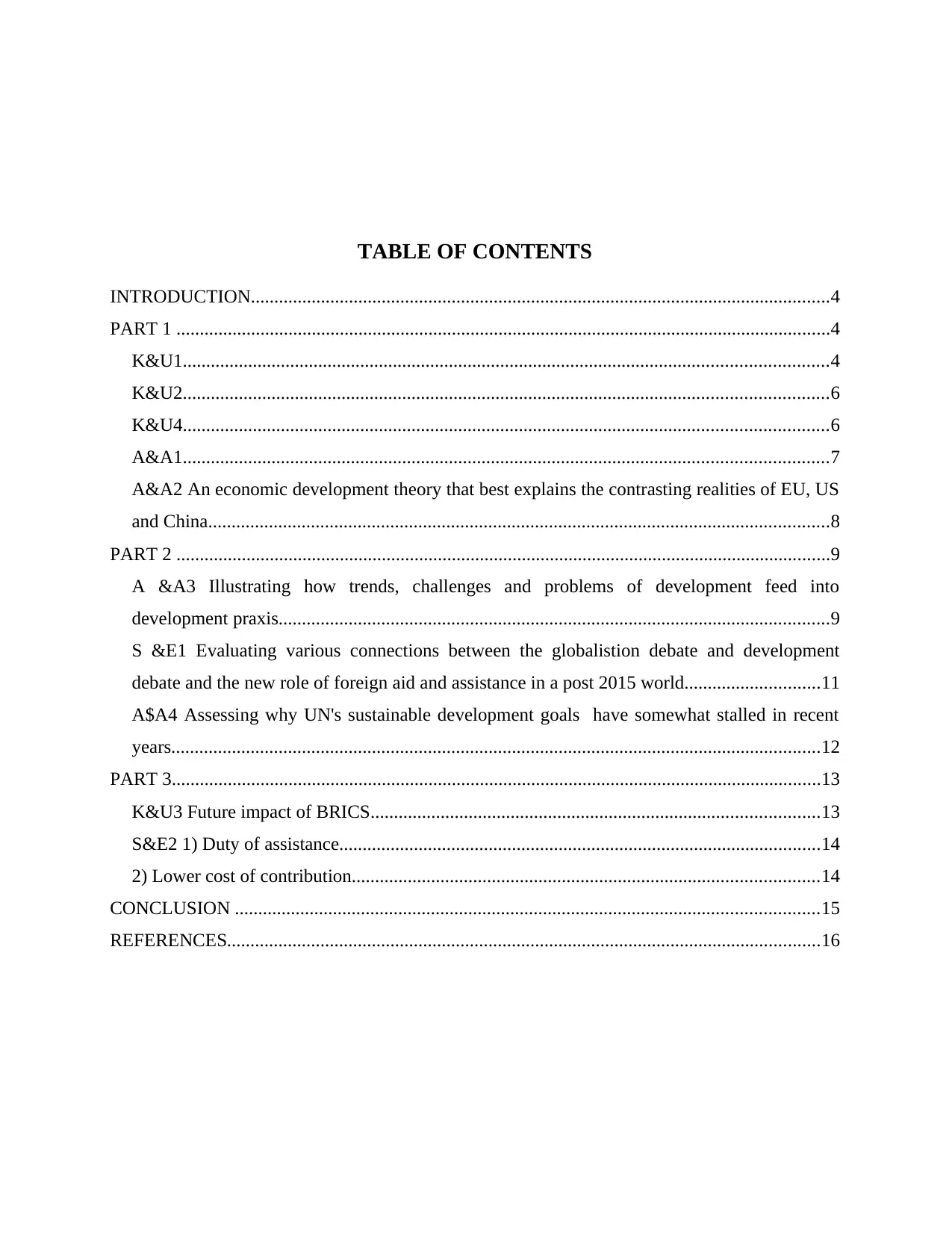
TABLE OF CONTENTS
INTRODUCTION............................................................................................................................4
PART 1 ............................................................................................................................................4
K&U1..........................................................................................................................................4
K&U2..........................................................................................................................................6
K&U4..........................................................................................................................................6
A&A1..........................................................................................................................................7
A&A2 An economic development theory that best explains the contrasting realities of EU, US
and China.....................................................................................................................................8
PART 2 ............................................................................................................................................9
A &A3 Illustrating how trends, challenges and problems of development feed into
development praxis......................................................................................................................9
S &E1 Evaluating various connections between the globalistion debate and development
debate and the new role of foreign aid and assistance in a post 2015 world.............................11
A$A4 Assessing why UN's sustainable development goals have somewhat stalled in recent
years...........................................................................................................................................12
PART 3...........................................................................................................................................13
K&U3 Future impact of BRICS................................................................................................13
S&E2 1) Duty of assistance.......................................................................................................14
2) Lower cost of contribution....................................................................................................14
CONCLUSION .............................................................................................................................15
REFERENCES...............................................................................................................................16
INTRODUCTION............................................................................................................................4
PART 1 ............................................................................................................................................4
K&U1..........................................................................................................................................4
K&U2..........................................................................................................................................6
K&U4..........................................................................................................................................6
A&A1..........................................................................................................................................7
A&A2 An economic development theory that best explains the contrasting realities of EU, US
and China.....................................................................................................................................8
PART 2 ............................................................................................................................................9
A &A3 Illustrating how trends, challenges and problems of development feed into
development praxis......................................................................................................................9
S &E1 Evaluating various connections between the globalistion debate and development
debate and the new role of foreign aid and assistance in a post 2015 world.............................11
A$A4 Assessing why UN's sustainable development goals have somewhat stalled in recent
years...........................................................................................................................................12
PART 3...........................................................................................................................................13
K&U3 Future impact of BRICS................................................................................................13
S&E2 1) Duty of assistance.......................................................................................................14
2) Lower cost of contribution....................................................................................................14
CONCLUSION .............................................................................................................................15
REFERENCES...............................................................................................................................16

⊘ This is a preview!⊘
Do you want full access?
Subscribe today to unlock all pages.

Trusted by 1+ million students worldwide
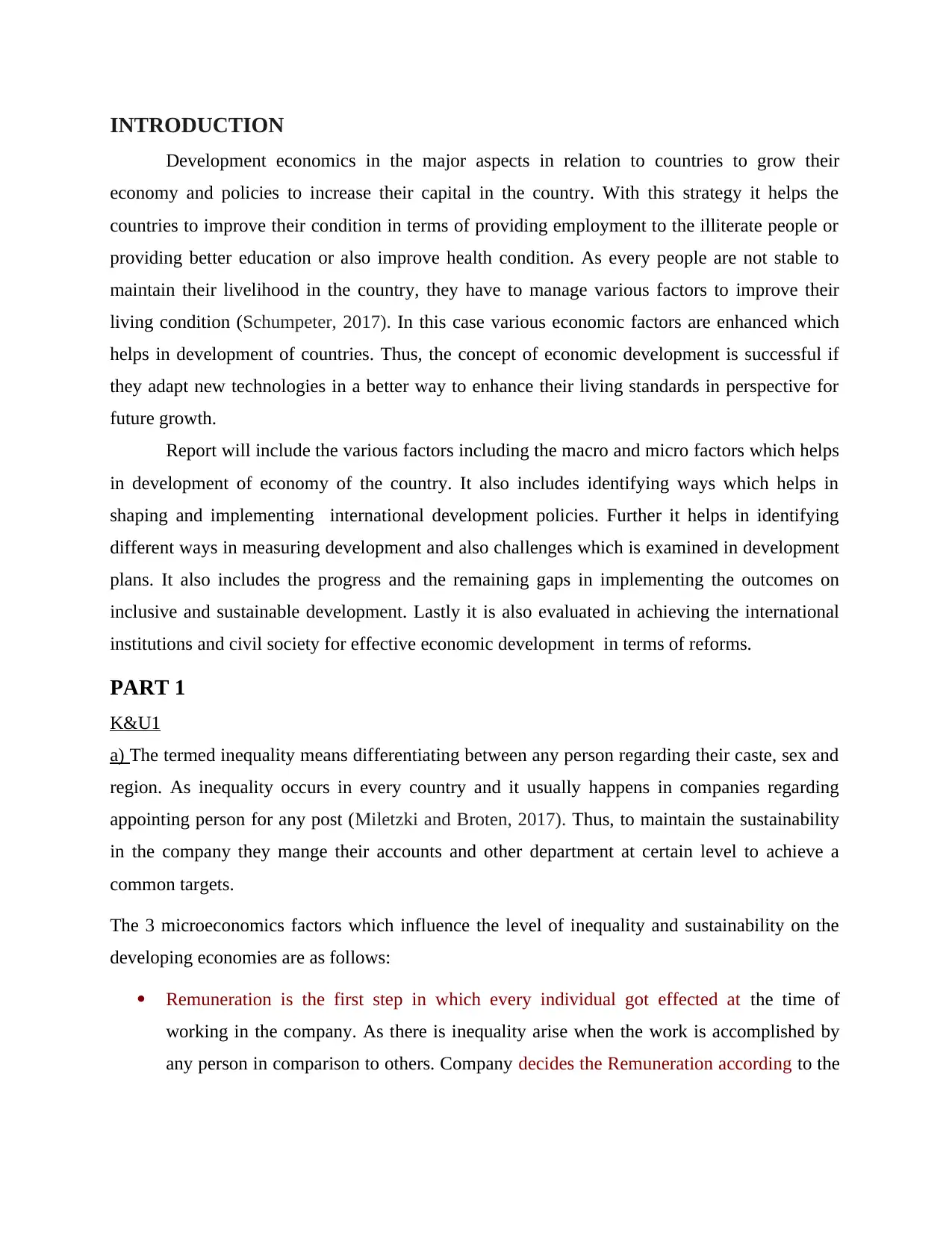
INTRODUCTION
Development economics in the major aspects in relation to countries to grow their
economy and policies to increase their capital in the country. With this strategy it helps the
countries to improve their condition in terms of providing employment to the illiterate people or
providing better education or also improve health condition. As every people are not stable to
maintain their livelihood in the country, they have to manage various factors to improve their
living condition (Schumpeter, 2017). In this case various economic factors are enhanced which
helps in development of countries. Thus, the concept of economic development is successful if
they adapt new technologies in a better way to enhance their living standards in perspective for
future growth.
Report will include the various factors including the macro and micro factors which helps
in development of economy of the country. It also includes identifying ways which helps in
shaping and implementing international development policies. Further it helps in identifying
different ways in measuring development and also challenges which is examined in development
plans. It also includes the progress and the remaining gaps in implementing the outcomes on
inclusive and sustainable development. Lastly it is also evaluated in achieving the international
institutions and civil society for effective economic development in terms of reforms.
PART 1
K&U1
a) The termed inequality means differentiating between any person regarding their caste, sex and
region. As inequality occurs in every country and it usually happens in companies regarding
appointing person for any post (Miletzki and Broten, 2017). Thus, to maintain the sustainability
in the company they mange their accounts and other department at certain level to achieve a
common targets.
The 3 microeconomics factors which influence the level of inequality and sustainability on the
developing economies are as follows:
Remuneration is the first step in which every individual got effected at the time of
working in the company. As there is inequality arise when the work is accomplished by
any person in comparison to others. Company decides the Remuneration according to the
Development economics in the major aspects in relation to countries to grow their
economy and policies to increase their capital in the country. With this strategy it helps the
countries to improve their condition in terms of providing employment to the illiterate people or
providing better education or also improve health condition. As every people are not stable to
maintain their livelihood in the country, they have to manage various factors to improve their
living condition (Schumpeter, 2017). In this case various economic factors are enhanced which
helps in development of countries. Thus, the concept of economic development is successful if
they adapt new technologies in a better way to enhance their living standards in perspective for
future growth.
Report will include the various factors including the macro and micro factors which helps
in development of economy of the country. It also includes identifying ways which helps in
shaping and implementing international development policies. Further it helps in identifying
different ways in measuring development and also challenges which is examined in development
plans. It also includes the progress and the remaining gaps in implementing the outcomes on
inclusive and sustainable development. Lastly it is also evaluated in achieving the international
institutions and civil society for effective economic development in terms of reforms.
PART 1
K&U1
a) The termed inequality means differentiating between any person regarding their caste, sex and
region. As inequality occurs in every country and it usually happens in companies regarding
appointing person for any post (Miletzki and Broten, 2017). Thus, to maintain the sustainability
in the company they mange their accounts and other department at certain level to achieve a
common targets.
The 3 microeconomics factors which influence the level of inequality and sustainability on the
developing economies are as follows:
Remuneration is the first step in which every individual got effected at the time of
working in the company. As there is inequality arise when the work is accomplished by
any person in comparison to others. Company decides the Remuneration according to the
Paraphrase This Document
Need a fresh take? Get an instant paraphrase of this document with our AI Paraphraser

work accomplishment and if the person achieve more targets than he is liable to be paid
more (Coale and Hoover, 2015).
Care and safety is the another important aspects as the individual which are poor or
cannot afford their health expense are usually neglected by the company. In that case
inequality arises which is to be rectifiers as all the employees are equal and their heath
maintenance which the company affords should be maintained and manage properly
(Platteau, 2015).
Training and development related issue are mostly occurs in case of inequality. In this,
most companies avoid such person which are of different caste and also they not provide
proper guidance to achieve goal in the organisation. By these factors they avoid
appointing any person of lower caste and not having adequate knowledge to learn
something.
The 3 macro economic factors which influence the level of inequality and sustainability are as
follows:
The factors related to employment Act, in this mainly companies prefer the person which
are employed and had proper experience to handle the work loads. In this case they
commit inequality with the employees which had the least knowledge but can work in
better way to achieve goal (Van den Berg, 2016).
Tax regulation is the another important concept which is generally finds in respect of
inequality and sustainability in which the companies is facing in case of expanding their
business in international market. As different countries had different government to rule
on and there tax system also depends upon the quantity of goods imported and exported
in this case inequality and sustainability occurs to balance their working structure.
In this global world, global changes which occurs due to changes in environment in this
the company which had renowned brand name can easily enter into the market and they
can expend their business but with the company having less brand image had to struggle
to enhance their name. This is the major factors of inequality in the country (Croes,
Ridderstaat and van Niekerk, 2018).
more (Coale and Hoover, 2015).
Care and safety is the another important aspects as the individual which are poor or
cannot afford their health expense are usually neglected by the company. In that case
inequality arises which is to be rectifiers as all the employees are equal and their heath
maintenance which the company affords should be maintained and manage properly
(Platteau, 2015).
Training and development related issue are mostly occurs in case of inequality. In this,
most companies avoid such person which are of different caste and also they not provide
proper guidance to achieve goal in the organisation. By these factors they avoid
appointing any person of lower caste and not having adequate knowledge to learn
something.
The 3 macro economic factors which influence the level of inequality and sustainability are as
follows:
The factors related to employment Act, in this mainly companies prefer the person which
are employed and had proper experience to handle the work loads. In this case they
commit inequality with the employees which had the least knowledge but can work in
better way to achieve goal (Van den Berg, 2016).
Tax regulation is the another important concept which is generally finds in respect of
inequality and sustainability in which the companies is facing in case of expanding their
business in international market. As different countries had different government to rule
on and there tax system also depends upon the quantity of goods imported and exported
in this case inequality and sustainability occurs to balance their working structure.
In this global world, global changes which occurs due to changes in environment in this
the company which had renowned brand name can easily enter into the market and they
can expend their business but with the company having less brand image had to struggle
to enhance their name. This is the major factors of inequality in the country (Croes,
Ridderstaat and van Niekerk, 2018).
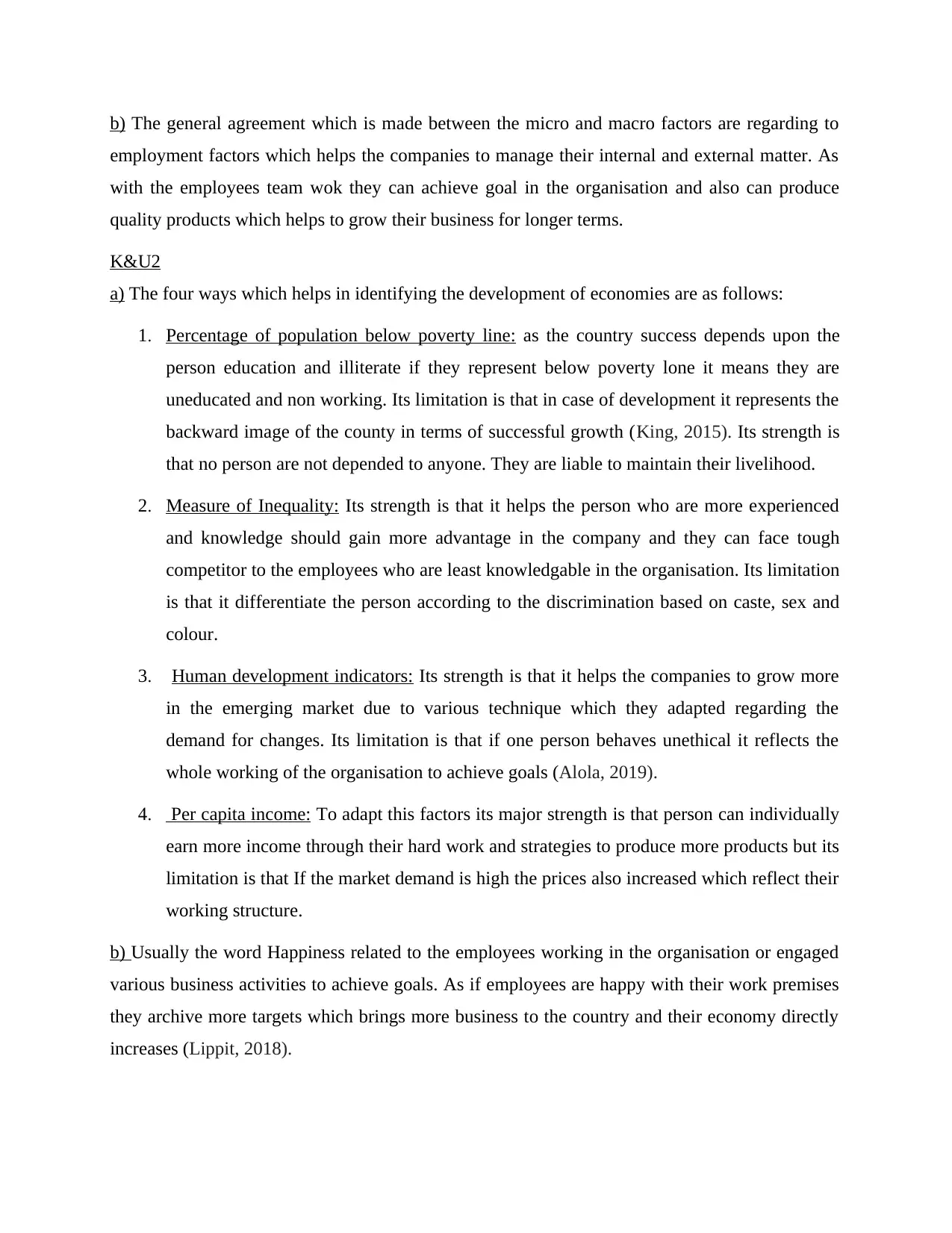
b) The general agreement which is made between the micro and macro factors are regarding to
employment factors which helps the companies to manage their internal and external matter. As
with the employees team wok they can achieve goal in the organisation and also can produce
quality products which helps to grow their business for longer terms.
K&U2
a) The four ways which helps in identifying the development of economies are as follows:
1. Percentage of population below poverty line: as the country success depends upon the
person education and illiterate if they represent below poverty lone it means they are
uneducated and non working. Its limitation is that in case of development it represents the
backward image of the county in terms of successful growth (King, 2015). Its strength is
that no person are not depended to anyone. They are liable to maintain their livelihood.
2. Measure of Inequality: Its strength is that it helps the person who are more experienced
and knowledge should gain more advantage in the company and they can face tough
competitor to the employees who are least knowledgable in the organisation. Its limitation
is that it differentiate the person according to the discrimination based on caste, sex and
colour.
3. Human development indicators: Its strength is that it helps the companies to grow more
in the emerging market due to various technique which they adapted regarding the
demand for changes. Its limitation is that if one person behaves unethical it reflects the
whole working of the organisation to achieve goals (Alola, 2019).
4. Per capita income: To adapt this factors its major strength is that person can individually
earn more income through their hard work and strategies to produce more products but its
limitation is that If the market demand is high the prices also increased which reflect their
working structure.
b) Usually the word Happiness related to the employees working in the organisation or engaged
various business activities to achieve goals. As if employees are happy with their work premises
they archive more targets which brings more business to the country and their economy directly
increases (Lippit, 2018).
employment factors which helps the companies to manage their internal and external matter. As
with the employees team wok they can achieve goal in the organisation and also can produce
quality products which helps to grow their business for longer terms.
K&U2
a) The four ways which helps in identifying the development of economies are as follows:
1. Percentage of population below poverty line: as the country success depends upon the
person education and illiterate if they represent below poverty lone it means they are
uneducated and non working. Its limitation is that in case of development it represents the
backward image of the county in terms of successful growth (King, 2015). Its strength is
that no person are not depended to anyone. They are liable to maintain their livelihood.
2. Measure of Inequality: Its strength is that it helps the person who are more experienced
and knowledge should gain more advantage in the company and they can face tough
competitor to the employees who are least knowledgable in the organisation. Its limitation
is that it differentiate the person according to the discrimination based on caste, sex and
colour.
3. Human development indicators: Its strength is that it helps the companies to grow more
in the emerging market due to various technique which they adapted regarding the
demand for changes. Its limitation is that if one person behaves unethical it reflects the
whole working of the organisation to achieve goals (Alola, 2019).
4. Per capita income: To adapt this factors its major strength is that person can individually
earn more income through their hard work and strategies to produce more products but its
limitation is that If the market demand is high the prices also increased which reflect their
working structure.
b) Usually the word Happiness related to the employees working in the organisation or engaged
various business activities to achieve goals. As if employees are happy with their work premises
they archive more targets which brings more business to the country and their economy directly
increases (Lippit, 2018).
⊘ This is a preview!⊘
Do you want full access?
Subscribe today to unlock all pages.

Trusted by 1+ million students worldwide
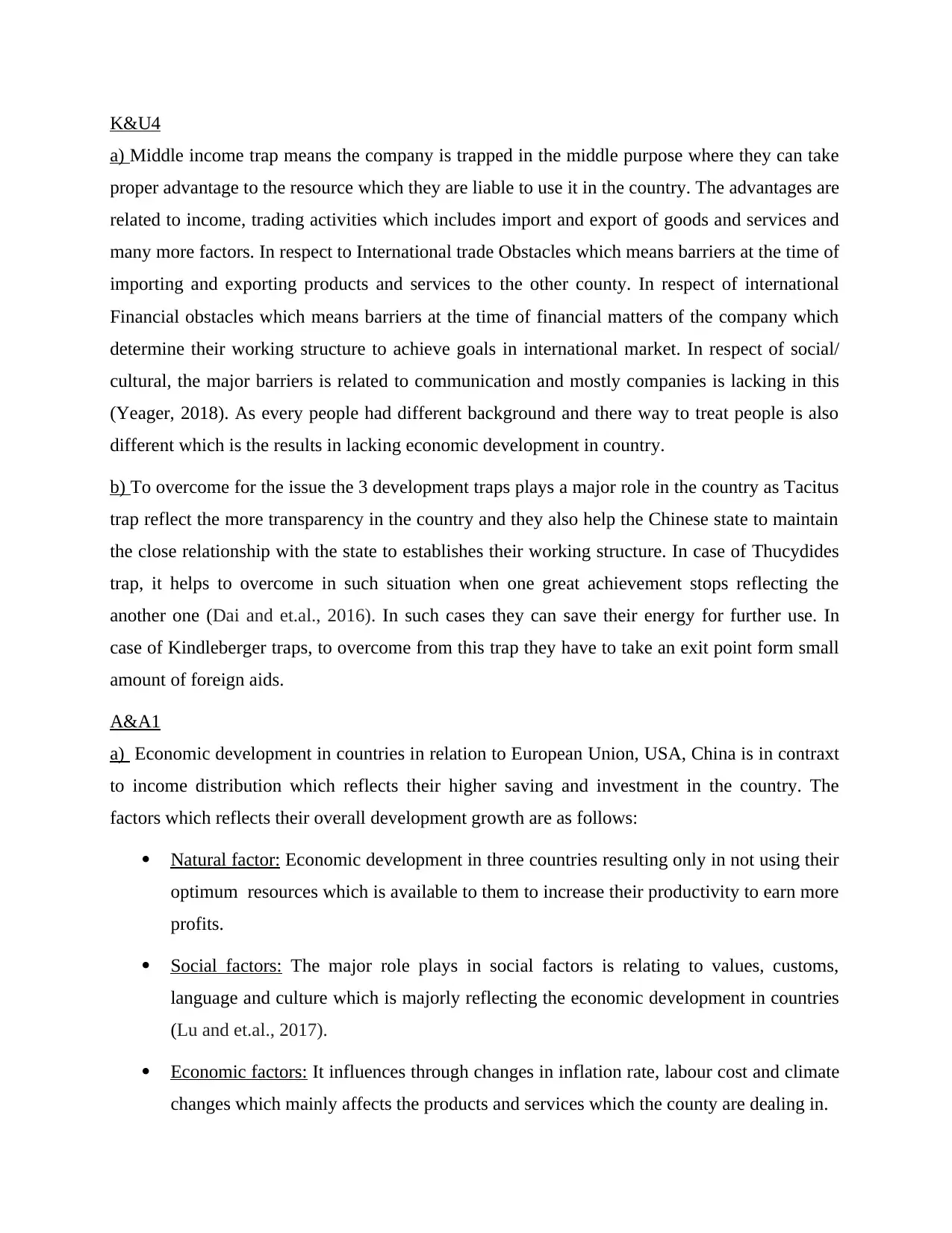
K&U4
a) Middle income trap means the company is trapped in the middle purpose where they can take
proper advantage to the resource which they are liable to use it in the country. The advantages are
related to income, trading activities which includes import and export of goods and services and
many more factors. In respect to International trade Obstacles which means barriers at the time of
importing and exporting products and services to the other county. In respect of international
Financial obstacles which means barriers at the time of financial matters of the company which
determine their working structure to achieve goals in international market. In respect of social/
cultural, the major barriers is related to communication and mostly companies is lacking in this
(Yeager, 2018). As every people had different background and there way to treat people is also
different which is the results in lacking economic development in country.
b) To overcome for the issue the 3 development traps plays a major role in the country as Tacitus
trap reflect the more transparency in the country and they also help the Chinese state to maintain
the close relationship with the state to establishes their working structure. In case of Thucydides
trap, it helps to overcome in such situation when one great achievement stops reflecting the
another one (Dai and et.al., 2016). In such cases they can save their energy for further use. In
case of Kindleberger traps, to overcome from this trap they have to take an exit point form small
amount of foreign aids.
A&A1
a) Economic development in countries in relation to European Union, USA, China is in contraxt
to income distribution which reflects their higher saving and investment in the country. The
factors which reflects their overall development growth are as follows:
Natural factor: Economic development in three countries resulting only in not using their
optimum resources which is available to them to increase their productivity to earn more
profits.
Social factors: The major role plays in social factors is relating to values, customs,
language and culture which is majorly reflecting the economic development in countries
(Lu and et.al., 2017).
Economic factors: It influences through changes in inflation rate, labour cost and climate
changes which mainly affects the products and services which the county are dealing in.
a) Middle income trap means the company is trapped in the middle purpose where they can take
proper advantage to the resource which they are liable to use it in the country. The advantages are
related to income, trading activities which includes import and export of goods and services and
many more factors. In respect to International trade Obstacles which means barriers at the time of
importing and exporting products and services to the other county. In respect of international
Financial obstacles which means barriers at the time of financial matters of the company which
determine their working structure to achieve goals in international market. In respect of social/
cultural, the major barriers is related to communication and mostly companies is lacking in this
(Yeager, 2018). As every people had different background and there way to treat people is also
different which is the results in lacking economic development in country.
b) To overcome for the issue the 3 development traps plays a major role in the country as Tacitus
trap reflect the more transparency in the country and they also help the Chinese state to maintain
the close relationship with the state to establishes their working structure. In case of Thucydides
trap, it helps to overcome in such situation when one great achievement stops reflecting the
another one (Dai and et.al., 2016). In such cases they can save their energy for further use. In
case of Kindleberger traps, to overcome from this trap they have to take an exit point form small
amount of foreign aids.
A&A1
a) Economic development in countries in relation to European Union, USA, China is in contraxt
to income distribution which reflects their higher saving and investment in the country. The
factors which reflects their overall development growth are as follows:
Natural factor: Economic development in three countries resulting only in not using their
optimum resources which is available to them to increase their productivity to earn more
profits.
Social factors: The major role plays in social factors is relating to values, customs,
language and culture which is majorly reflecting the economic development in countries
(Lu and et.al., 2017).
Economic factors: It influences through changes in inflation rate, labour cost and climate
changes which mainly affects the products and services which the county are dealing in.
Paraphrase This Document
Need a fresh take? Get an instant paraphrase of this document with our AI Paraphraser
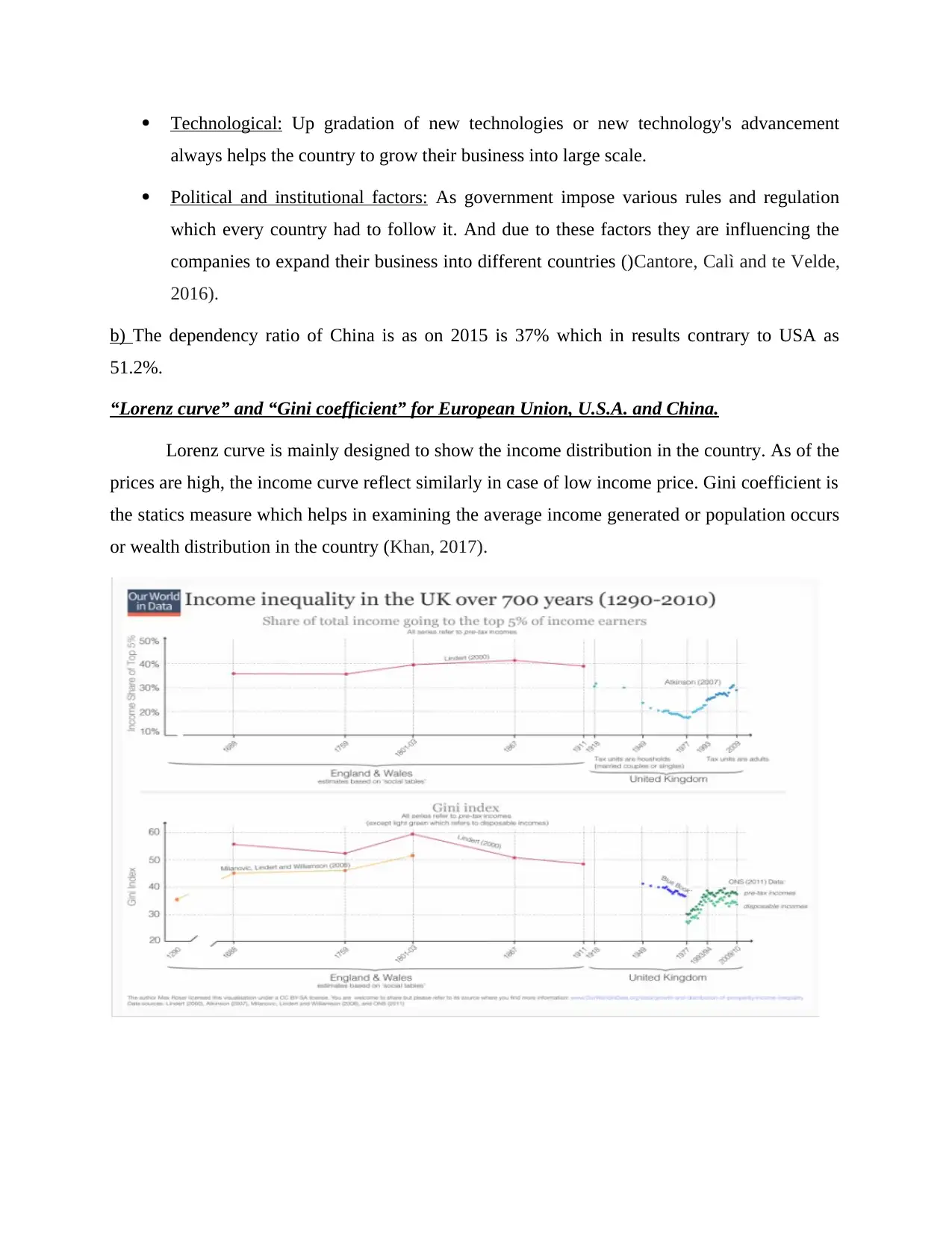
Technological: Up gradation of new technologies or new technology's advancement
always helps the country to grow their business into large scale.
Political and institutional factors: As government impose various rules and regulation
which every country had to follow it. And due to these factors they are influencing the
companies to expand their business into different countries ()Cantore, Calì and te Velde,
2016).
b) The dependency ratio of China is as on 2015 is 37% which in results contrary to USA as
51.2%.
“Lorenz curve” and “Gini coefficient” for European Union, U.S.A. and China.
Lorenz curve is mainly designed to show the income distribution in the country. As of the
prices are high, the income curve reflect similarly in case of low income price. Gini coefficient is
the statics measure which helps in examining the average income generated or population occurs
or wealth distribution in the country (Khan, 2017).
always helps the country to grow their business into large scale.
Political and institutional factors: As government impose various rules and regulation
which every country had to follow it. And due to these factors they are influencing the
companies to expand their business into different countries ()Cantore, Calì and te Velde,
2016).
b) The dependency ratio of China is as on 2015 is 37% which in results contrary to USA as
51.2%.
“Lorenz curve” and “Gini coefficient” for European Union, U.S.A. and China.
Lorenz curve is mainly designed to show the income distribution in the country. As of the
prices are high, the income curve reflect similarly in case of low income price. Gini coefficient is
the statics measure which helps in examining the average income generated or population occurs
or wealth distribution in the country (Khan, 2017).
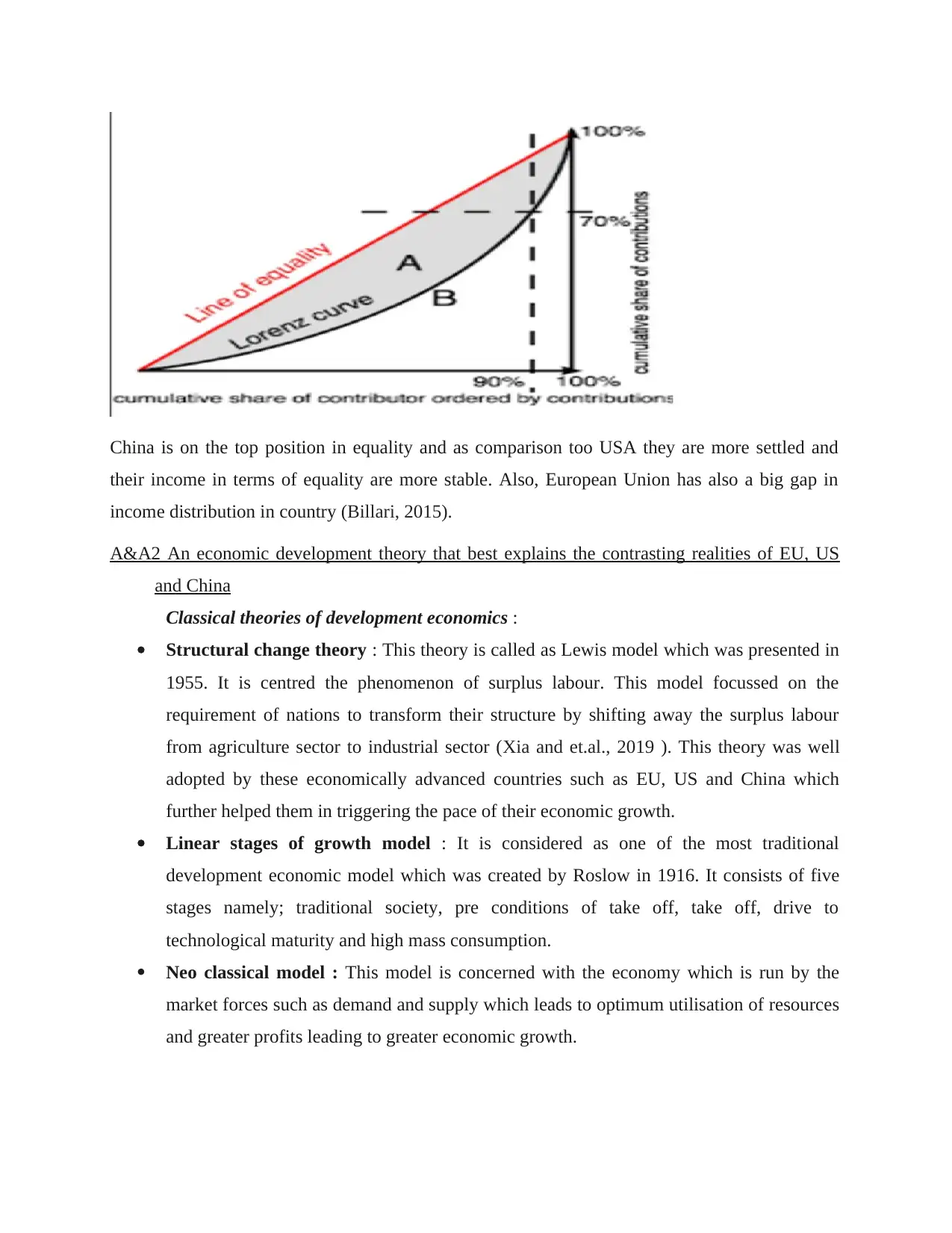
China is on the top position in equality and as comparison too USA they are more settled and
their income in terms of equality are more stable. Also, European Union has also a big gap in
income distribution in country (Billari, 2015).
A&A2 An economic development theory that best explains the contrasting realities of EU, US
and China
Classical theories of development economics :
Structural change theory : This theory is called as Lewis model which was presented in
1955. It is centred the phenomenon of surplus labour. This model focussed on the
requirement of nations to transform their structure by shifting away the surplus labour
from agriculture sector to industrial sector (Xia and et.al., 2019 ). This theory was well
adopted by these economically advanced countries such as EU, US and China which
further helped them in triggering the pace of their economic growth.
Linear stages of growth model : It is considered as one of the most traditional
development economic model which was created by Roslow in 1916. It consists of five
stages namely; traditional society, pre conditions of take off, take off, drive to
technological maturity and high mass consumption.
Neo classical model : This model is concerned with the economy which is run by the
market forces such as demand and supply which leads to optimum utilisation of resources
and greater profits leading to greater economic growth.
their income in terms of equality are more stable. Also, European Union has also a big gap in
income distribution in country (Billari, 2015).
A&A2 An economic development theory that best explains the contrasting realities of EU, US
and China
Classical theories of development economics :
Structural change theory : This theory is called as Lewis model which was presented in
1955. It is centred the phenomenon of surplus labour. This model focussed on the
requirement of nations to transform their structure by shifting away the surplus labour
from agriculture sector to industrial sector (Xia and et.al., 2019 ). This theory was well
adopted by these economically advanced countries such as EU, US and China which
further helped them in triggering the pace of their economic growth.
Linear stages of growth model : It is considered as one of the most traditional
development economic model which was created by Roslow in 1916. It consists of five
stages namely; traditional society, pre conditions of take off, take off, drive to
technological maturity and high mass consumption.
Neo classical model : This model is concerned with the economy which is run by the
market forces such as demand and supply which leads to optimum utilisation of resources
and greater profits leading to greater economic growth.
⊘ This is a preview!⊘
Do you want full access?
Subscribe today to unlock all pages.

Trusted by 1+ million students worldwide
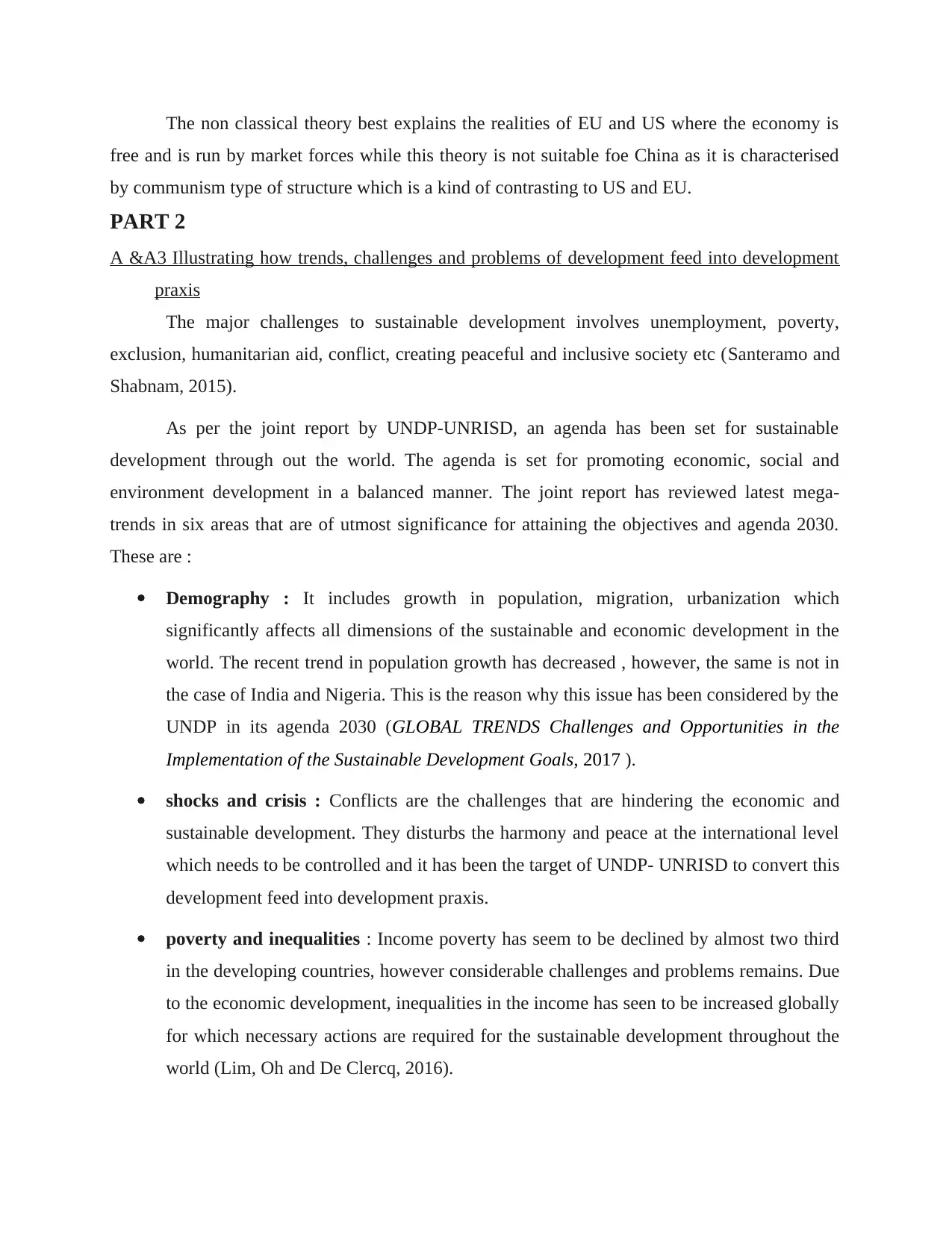
The non classical theory best explains the realities of EU and US where the economy is
free and is run by market forces while this theory is not suitable foe China as it is characterised
by communism type of structure which is a kind of contrasting to US and EU.
PART 2
A &A3 Illustrating how trends, challenges and problems of development feed into development
praxis
The major challenges to sustainable development involves unemployment, poverty,
exclusion, humanitarian aid, conflict, creating peaceful and inclusive society etc (Santeramo and
Shabnam, 2015).
As per the joint report by UNDP-UNRISD, an agenda has been set for sustainable
development through out the world. The agenda is set for promoting economic, social and
environment development in a balanced manner. The joint report has reviewed latest mega-
trends in six areas that are of utmost significance for attaining the objectives and agenda 2030.
These are :
Demography : It includes growth in population, migration, urbanization which
significantly affects all dimensions of the sustainable and economic development in the
world. The recent trend in population growth has decreased , however, the same is not in
the case of India and Nigeria. This is the reason why this issue has been considered by the
UNDP in its agenda 2030 (GLOBAL TRENDS Challenges and Opportunities in the
Implementation of the Sustainable Development Goals, 2017 ).
shocks and crisis : Conflicts are the challenges that are hindering the economic and
sustainable development. They disturbs the harmony and peace at the international level
which needs to be controlled and it has been the target of UNDP- UNRISD to convert this
development feed into development praxis.
poverty and inequalities : Income poverty has seem to be declined by almost two third
in the developing countries, however considerable challenges and problems remains. Due
to the economic development, inequalities in the income has seen to be increased globally
for which necessary actions are required for the sustainable development throughout the
world (Lim, Oh and De Clercq, 2016).
free and is run by market forces while this theory is not suitable foe China as it is characterised
by communism type of structure which is a kind of contrasting to US and EU.
PART 2
A &A3 Illustrating how trends, challenges and problems of development feed into development
praxis
The major challenges to sustainable development involves unemployment, poverty,
exclusion, humanitarian aid, conflict, creating peaceful and inclusive society etc (Santeramo and
Shabnam, 2015).
As per the joint report by UNDP-UNRISD, an agenda has been set for sustainable
development through out the world. The agenda is set for promoting economic, social and
environment development in a balanced manner. The joint report has reviewed latest mega-
trends in six areas that are of utmost significance for attaining the objectives and agenda 2030.
These are :
Demography : It includes growth in population, migration, urbanization which
significantly affects all dimensions of the sustainable and economic development in the
world. The recent trend in population growth has decreased , however, the same is not in
the case of India and Nigeria. This is the reason why this issue has been considered by the
UNDP in its agenda 2030 (GLOBAL TRENDS Challenges and Opportunities in the
Implementation of the Sustainable Development Goals, 2017 ).
shocks and crisis : Conflicts are the challenges that are hindering the economic and
sustainable development. They disturbs the harmony and peace at the international level
which needs to be controlled and it has been the target of UNDP- UNRISD to convert this
development feed into development praxis.
poverty and inequalities : Income poverty has seem to be declined by almost two third
in the developing countries, however considerable challenges and problems remains. Due
to the economic development, inequalities in the income has seen to be increased globally
for which necessary actions are required for the sustainable development throughout the
world (Lim, Oh and De Clercq, 2016).
Paraphrase This Document
Need a fresh take? Get an instant paraphrase of this document with our AI Paraphraser
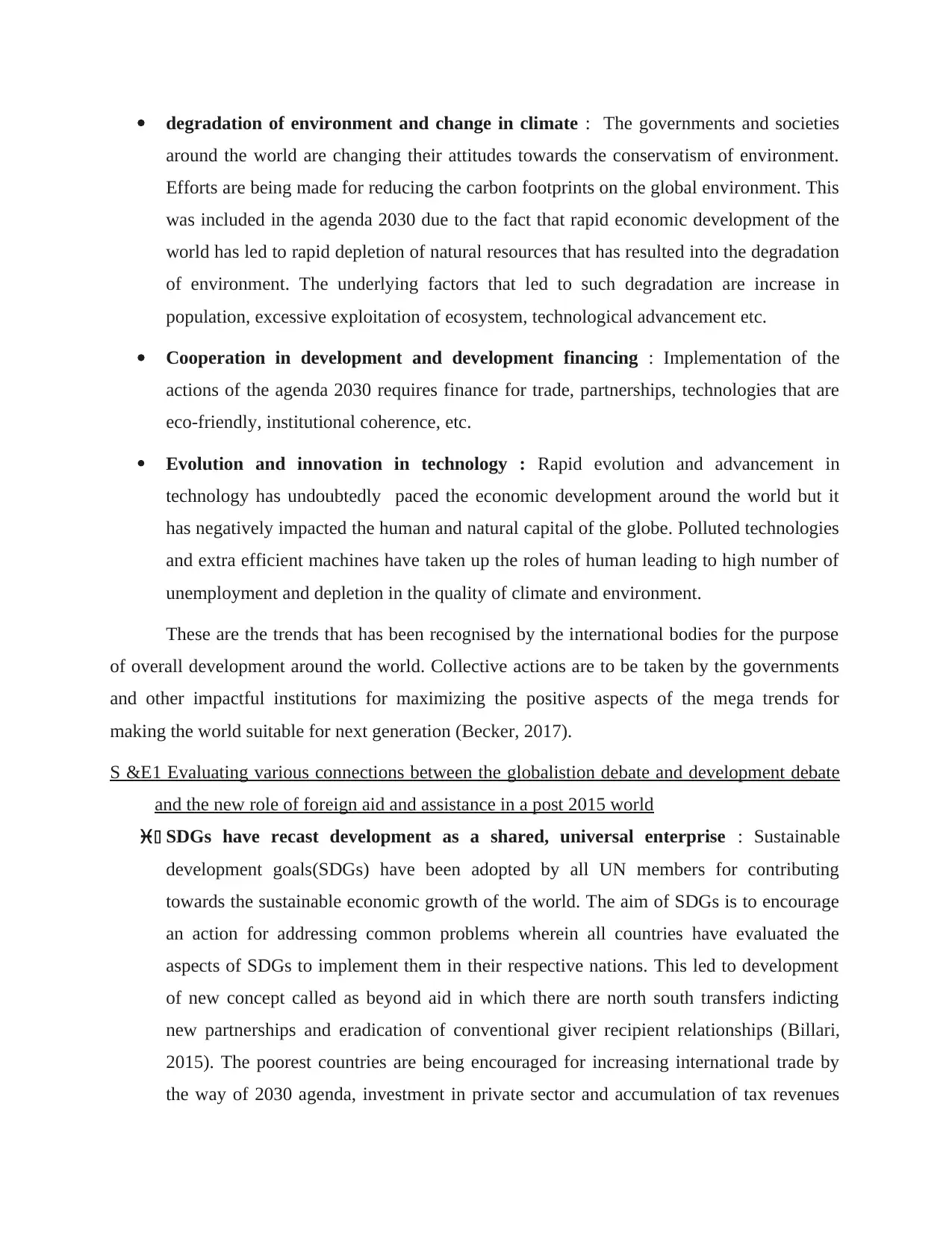
degradation of environment and change in climate : The governments and societies
around the world are changing their attitudes towards the conservatism of environment.
Efforts are being made for reducing the carbon footprints on the global environment. This
was included in the agenda 2030 due to the fact that rapid economic development of the
world has led to rapid depletion of natural resources that has resulted into the degradation
of environment. The underlying factors that led to such degradation are increase in
population, excessive exploitation of ecosystem, technological advancement etc.
Cooperation in development and development financing : Implementation of the
actions of the agenda 2030 requires finance for trade, partnerships, technologies that are
eco-friendly, institutional coherence, etc.
Evolution and innovation in technology : Rapid evolution and advancement in
technology has undoubtedly paced the economic development around the world but it
has negatively impacted the human and natural capital of the globe. Polluted technologies
and extra efficient machines have taken up the roles of human leading to high number of
unemployment and depletion in the quality of climate and environment.
These are the trends that has been recognised by the international bodies for the purpose
of overall development around the world. Collective actions are to be taken by the governments
and other impactful institutions for maximizing the positive aspects of the mega trends for
making the world suitable for next generation (Becker, 2017).
S &E1 Evaluating various connections between the globalistion debate and development debate
and the new role of foreign aid and assistance in a post 2015 world
.i SDGs have recast development as a shared, universal enterprise : Sustainable
development goals(SDGs) have been adopted by all UN members for contributing
towards the sustainable economic growth of the world. The aim of SDGs is to encourage
an action for addressing common problems wherein all countries have evaluated the
aspects of SDGs to implement them in their respective nations. This led to development
of new concept called as beyond aid in which there are north south transfers indicting
new partnerships and eradication of conventional giver recipient relationships (Billari,
2015). The poorest countries are being encouraged for increasing international trade by
the way of 2030 agenda, investment in private sector and accumulation of tax revenues
around the world are changing their attitudes towards the conservatism of environment.
Efforts are being made for reducing the carbon footprints on the global environment. This
was included in the agenda 2030 due to the fact that rapid economic development of the
world has led to rapid depletion of natural resources that has resulted into the degradation
of environment. The underlying factors that led to such degradation are increase in
population, excessive exploitation of ecosystem, technological advancement etc.
Cooperation in development and development financing : Implementation of the
actions of the agenda 2030 requires finance for trade, partnerships, technologies that are
eco-friendly, institutional coherence, etc.
Evolution and innovation in technology : Rapid evolution and advancement in
technology has undoubtedly paced the economic development around the world but it
has negatively impacted the human and natural capital of the globe. Polluted technologies
and extra efficient machines have taken up the roles of human leading to high number of
unemployment and depletion in the quality of climate and environment.
These are the trends that has been recognised by the international bodies for the purpose
of overall development around the world. Collective actions are to be taken by the governments
and other impactful institutions for maximizing the positive aspects of the mega trends for
making the world suitable for next generation (Becker, 2017).
S &E1 Evaluating various connections between the globalistion debate and development debate
and the new role of foreign aid and assistance in a post 2015 world
.i SDGs have recast development as a shared, universal enterprise : Sustainable
development goals(SDGs) have been adopted by all UN members for contributing
towards the sustainable economic growth of the world. The aim of SDGs is to encourage
an action for addressing common problems wherein all countries have evaluated the
aspects of SDGs to implement them in their respective nations. This led to development
of new concept called as beyond aid in which there are north south transfers indicting
new partnerships and eradication of conventional giver recipient relationships (Billari,
2015). The poorest countries are being encouraged for increasing international trade by
the way of 2030 agenda, investment in private sector and accumulation of tax revenues
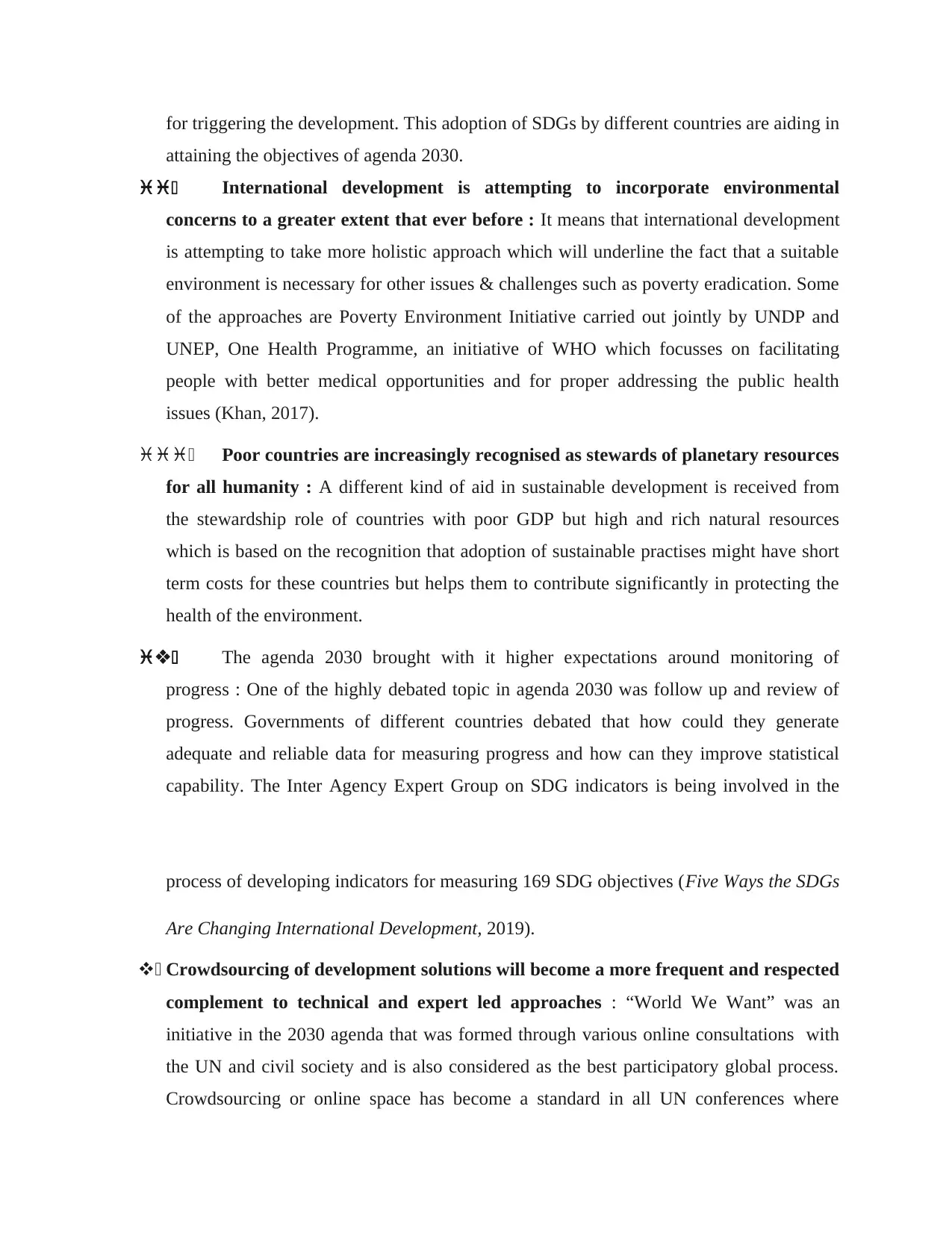
for triggering the development. This adoption of SDGs by different countries are aiding in
attaining the objectives of agenda 2030.
.ii International development is attempting to incorporate environmental
concerns to a greater extent that ever before : It means that international development
is attempting to take more holistic approach which will underline the fact that a suitable
environment is necessary for other issues & challenges such as poverty eradication. Some
of the approaches are Poverty Environment Initiative carried out jointly by UNDP and
UNEP, One Health Programme, an initiative of WHO which focusses on facilitating
people with better medical opportunities and for proper addressing the public health
issues (Khan, 2017).
.iii Poor countries are increasingly recognised as stewards of planetary resources
for all humanity : A different kind of aid in sustainable development is received from
the stewardship role of countries with poor GDP but high and rich natural resources
which is based on the recognition that adoption of sustainable practises might have short
term costs for these countries but helps them to contribute significantly in protecting the
health of the environment.
v.i The agenda 2030 brought with it higher expectations around monitoring of
progress : One of the highly debated topic in agenda 2030 was follow up and review of
progress. Governments of different countries debated that how could they generate
adequate and reliable data for measuring progress and how can they improve statistical
capability. The Inter Agency Expert Group on SDG indicators is being involved in the
process of developing indicators for measuring 169 SDG objectives (Five Ways the SDGs
Are Changing International Development, 2019).
v. Crowdsourcing of development solutions will become a more frequent and respected
complement to technical and expert led approaches : “World We Want” was an
initiative in the 2030 agenda that was formed through various online consultations with
the UN and civil society and is also considered as the best participatory global process.
Crowdsourcing or online space has become a standard in all UN conferences where
attaining the objectives of agenda 2030.
.ii International development is attempting to incorporate environmental
concerns to a greater extent that ever before : It means that international development
is attempting to take more holistic approach which will underline the fact that a suitable
environment is necessary for other issues & challenges such as poverty eradication. Some
of the approaches are Poverty Environment Initiative carried out jointly by UNDP and
UNEP, One Health Programme, an initiative of WHO which focusses on facilitating
people with better medical opportunities and for proper addressing the public health
issues (Khan, 2017).
.iii Poor countries are increasingly recognised as stewards of planetary resources
for all humanity : A different kind of aid in sustainable development is received from
the stewardship role of countries with poor GDP but high and rich natural resources
which is based on the recognition that adoption of sustainable practises might have short
term costs for these countries but helps them to contribute significantly in protecting the
health of the environment.
v.i The agenda 2030 brought with it higher expectations around monitoring of
progress : One of the highly debated topic in agenda 2030 was follow up and review of
progress. Governments of different countries debated that how could they generate
adequate and reliable data for measuring progress and how can they improve statistical
capability. The Inter Agency Expert Group on SDG indicators is being involved in the
process of developing indicators for measuring 169 SDG objectives (Five Ways the SDGs
Are Changing International Development, 2019).
v. Crowdsourcing of development solutions will become a more frequent and respected
complement to technical and expert led approaches : “World We Want” was an
initiative in the 2030 agenda that was formed through various online consultations with
the UN and civil society and is also considered as the best participatory global process.
Crowdsourcing or online space has become a standard in all UN conferences where
⊘ This is a preview!⊘
Do you want full access?
Subscribe today to unlock all pages.

Trusted by 1+ million students worldwide
1 out of 18
Related Documents
Your All-in-One AI-Powered Toolkit for Academic Success.
+13062052269
info@desklib.com
Available 24*7 on WhatsApp / Email
![[object Object]](/_next/static/media/star-bottom.7253800d.svg)
Unlock your academic potential
Copyright © 2020–2025 A2Z Services. All Rights Reserved. Developed and managed by ZUCOL.





